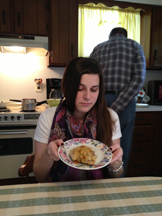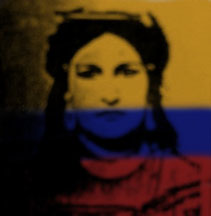While some participants struggled to make connections to their cultural identity, others, like the two participants about to be discussed, were able to tap into their cultural heritage and creatively explore moments of “jam.” One participant, Jane, performed an experiment as her performance and tested the meaning of words and the shifting of definitions between different cultures. Words she asked us to define were “awhile,” “fress,” “all,” and “stuffing.” We learned that in Pennsylvania Dutch, “awhile” does not mean something you are going to do later, but something you are doing right now. “Fress” is a derivative of the German word “fressen,” meaning you are eating an animal, so when you say you are “fressing” it means you are eating a lot. “Stuffing” is a traditional food she is holding in her hands in her self-portrait (Figure 2), and “all” is what you say when something is empty or finished, i.e. “The glass is all.”
During the explanation of her performance, Jane stated,

I never realized I spoke differently than some people until I came to [our university] because I grew up in York County and it’s a very Pennsylvania Dutch area and when I’m with my grandparents who are basically my second parents and I spend all my time with them, I talk really ridiculously like you wouldn’t recognize the way I speak. I say hamburg; I say fress; I cut the endings off of everything. It’s just really strange. (personal communication, December 4, 2012)
She noted that this change of speech caused a few troubles when she first got to university, so now, she actively monitors her speech around people who are not part of Pennsylvania Dutch culture in order to avoid misunderstandings.
*Read a transcript of Jane’s performance or her narrative responses.
Angela, another participant, brought a very interesting point of view into this project. Her and her identical twin sister were adopted from Colombia and raised in Pennsylvania since they were infants. Her self-portrait is actually an image of her birth mother (Figure 3). During her performance, she stood before the image of her mom and read a poem recounting her experiences growing up and viewing herself as White (Appendix B). Later in her life, her skin color began to set her apart from her White friends, and in college, she experienced a change in her understanding of her cultural identity. In her narrative, she stated, “Now that I am a twenty-two year old woman who has attended college, become immersed with different ethnicities, and found my biological mother, my views as to how I identify myself have changed drastically” (personal communication, December 4, 2012). In her poem and narrative she talks about “guilt” for not being a good Colombian:

While I struggle to implement these [Colombian rituals and practices] into my daily life I always find myself thinking, “I am privileged”. I cannot truly identify with my people because I am detached in so many ways. I feel extreme guilt for this. This is why I believe I consider myself to be Caucasian sometimes. (personal communication, December 4, 2012)
After her performance, she explains, “So, upon writing this, I never realized that I truly believed that when I was growing up I was White. I just fit in…And I think that I’m finally identifying with the fact that I’m not the norm that I am different as I meet Spanish people” (personal communication, December 4, 2012). Like Mallory found comfort in others sharing their disconnect with culture, Angela found comfort in my performance in which I shared my own feelings of not truly belonging to Latino culture because I do not speak Spanish. I was touched that I was able to offer her a shared experience, and, truthfully, this project helped us gain a deeper understanding of one another.
*Read Angela’s poem or her narrative responses.